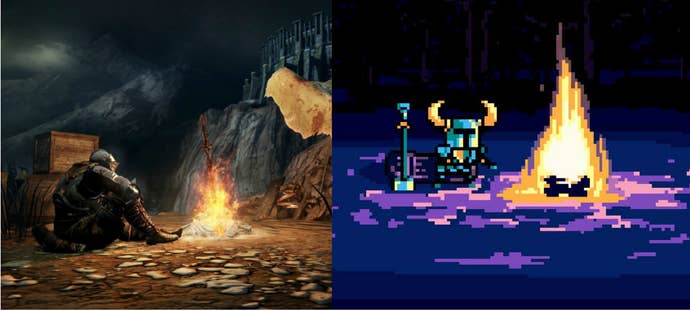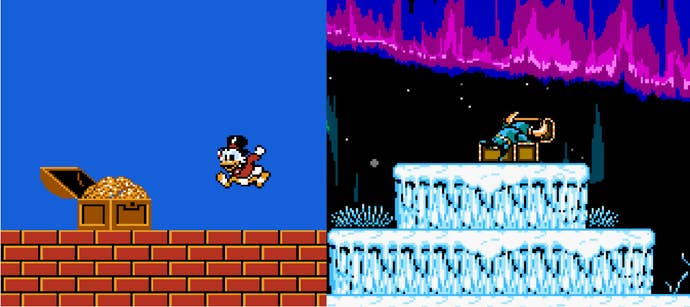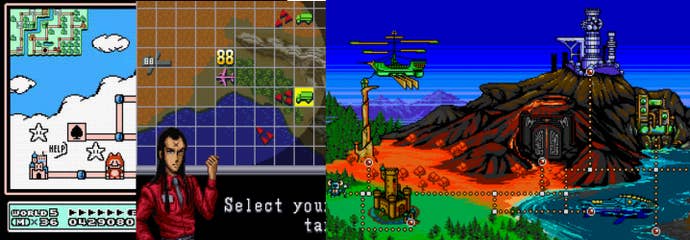Game Dev Recipes: Shovel Knight
Here's a look at some of the games that inspired Yacht Club Games' Shovel Knight.
This article first appeared on USgamer, a partner publication of VG247. Some content, such as this article, has been migrated to VG247 for posterity after USgamer's closure - but it has not been edited or further vetted by the VG247 team.
One part of any creative endeavor is inspiration. Sometimes, we're so focused on innovation for innovation's sake that we forget some of the amazing things that come from being inspired by other work. Many of your favorite scifi films draw inspiration from German Expressionist works like Fritz Lang's Metropolis. Shakespeare borrowed ideas from the works of Geoffery Chaucer and Ovid. Things that struck a chord with creators in their past are remixed, redone, and reused to create new art. The same is true when we skip from film and literature into video games.
Many developers are inspired by a host of old games. These older titles are full of successful and unsuccessful ideas, from which current developers can pick and choose. These ideas are thrown into the development pot to cook, simmer, and marinate, until finally a finished game stands ready to inspire a new generation of developers. This series is intended to look at recent games and see what classics inspired them.
We're kicking off Game Dev Recipes with a look at Yacht Club Games' Shovel Knight. The Kickstarted action-adventure relies on an 8-bit aesthetic and recalls a number of classic NES games. We reached out to the developer to find out what games inspired the creation of Shovel Knight and some of its mechanics.

Zelda II: The Adventure of Link (45 Percent)
NES | 1988
Shovel Knight's attack mechanics, which include extensive melee combat and a downward shovel stab, seem to be inspired by Link's stylish moves in Zelda II: The Adventure of Link.
Yacht Club Says:
-
As we've mentioned, the close encounter combat and the downward stab were definitely largely influenced by Zelda II. The influence extends further to our characters and world. Shovel Knight's world has a village very similar to Zelda II, where random passersbys will chat up Shovel Knight. Our characters are just as goofy and fun as the ones you'd find in the land of Hyrule too.
Mega Man (30 Percent)
NES | 1987

Shovel Knight brings back the pick-your-poison boss style that Capcom's Mega Man gave to world so long ago. Each boss has their own specific theme and a title that ties them together; while Mega Man's Robot Masters all had "Man" in their names, Shovel Knight's Order of No Quarter sticks with the "Knight" moniker.
Yacht Club Says:
-
Themed stages around bosses has always been a strong part of Mega Man. We think it really helps make the stages feel creative and unique. In the end it leaves you with something that's hard to forget. Putting a heavy focus on the cast and how their personalities shape the world is part of what makes games so fun to partake in!
- Besides just the boss presentation, the actual stage layout is room-based, which was important to our design. Something very unique to NES games is how the worlds are compact, and the gameplay per square inch, compared to modern games, is exponentially larger. Starting with room-based designs made the process of replicating that much easier because you can point to each room and say exactly what makes that section of the game interesting and fun. It becomes easy to mark the rooms that need work or are repetitious because they are already discretely separated as one progresses through the level.
Castlevania (15 Percent)
NES | 1986

Like old-school Simon Belmont, who was killing Dracula before all these Metroidvania whipper-snappers popped up, Shovel Knight has extra items at his disposal. And like Castlevania, SK's relic subweapons are limited in use; anything goes as long as you have the mana for it. Unlike Castlevania, Shovel Knight's relics don't leave you behind when you die. Score.
Yacht Club Says:
-
We definitely were struck by Castlevania's use of items. It's interesting that they aren't forced on you, but play a major part in how you can tackle each scenario and enemy in the game. There's always a clever way to use whatever weapon you have. In Shovel Knight, we took this idea and extended it even further. The items are useful in lots of ways, whether it be for platforming, enemies, or bosses. It's been interesting over the course of development how much people attach themselves to certain items based on their playstyle, which is very much in the vein of Castlevania. And you press Up and Attack to use them...so yeah, it's a bit like Castlevania!
Dark Souls (5 Percent)
PlayStation 3, Xbox 360, PC | 2011

Everyone is claiming to have a little Dark Souls in them, as if From Software's dungeon crawling adventure was the heir to a magnificent kingdom. A Yacht Club developer previously told USgamer's Kat Bailey that one encounter in the game was inspired by Dark Souls, but the connection runs deeper than that!
Yacht Club Says:
-
That combat encounter originally came from our love of fighting the Iron Knuckles in Zelda II. Our temporarily development name for him was actually Iron Knight. Let's be honest here, Dark Souls is really just an attempt at bringing the amazing combat from Zelda II to a 3D plane. So when we describe it as something taken from Zelda II, we really mean it was taken from Dark Souls too! The intense one-on-one fights in both games are something we find exhilarating, and we hope you find them as pleasing in Shovel Knight!
- Our checkpoint system might not directly remind you of Dark Souls, but the iteration of its design started from a place of thinking about how we could place such an important emphasis on player death as Dark Souls did. In our game, you can recover your lost money when you die similar to Dark Souls, but imagine if when you returned to the campfire, if you had the option of putting out the fire for a giant heap of cash! That's basically the risk/reward system we have set up. Any time you reach a checkpoint, you will return to it if you die, but you also have the option to break it with your shovel and benefit from a ton of gold instead.
Duck Tales (3 Percent)
NES | 1989

I wrongly assumed that the downward thrust move was from Capcom's Duck Tales for Nintendo, but there's still a bit of that game in Shovel Knight. The main character is out there looking for treasure wherever he can find it, just like Scrooge McDuck was.
Yacht Club Says:
-
The downthrust mechanic in our game, or the Shovel Drop as we call it, was mostly derived from Zelda II. That said, the feeling of discovering hidden treasure that is such an integral part to Duck Tales was definitely an inspiration for us. Hopefully that feeling of exploring every nook and cranny and being surprised at what's in store will bring a smile to everyone's face, just like it did in Duck Tales for the NES.
Super Mario Bros 3 (1 Percent)
NES | 1990
U.N. Squadron (1 Percent)
Super NES | 1991

I didn't even know these were a part of the recipe, so I'll leave it up to Yacht Club Games to explain how these titles influenced Shovel Knight.
Yacht Club Says:
-
Our world map, and stage progression in particular, were inspired by these two titles. Mario 3 remains in our minds when we recall what it's like to traverse a large NES world filled with surprises, while UN Squadron has more of a tiered map approach. That allows the player a choice in where they want to go while still escalating the challenge; without throwing the player into a completely flat stage structure.
Does all that sound awesome? Well you can still pre-order Shovel Knight on the official website for $15, which will net you a DRM-free PC key and a copy of the game on Steam. The game is also coming to Wii U and 3DS. When? Soon. Shovel Knight is finished but each platform holder is still certifying the game. Mac and Linux versions are also on the table, just not a launch.


